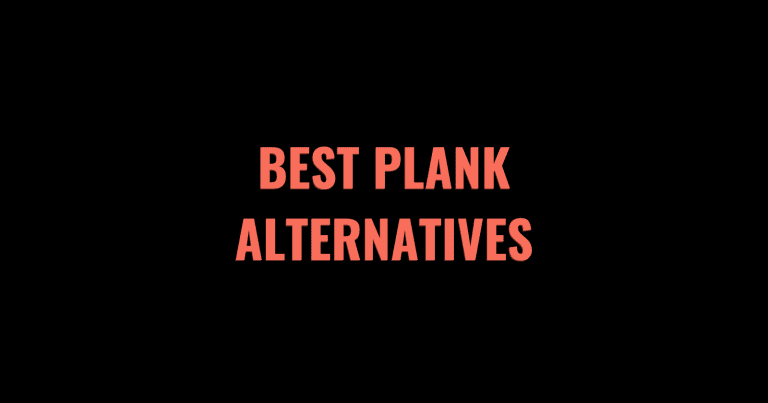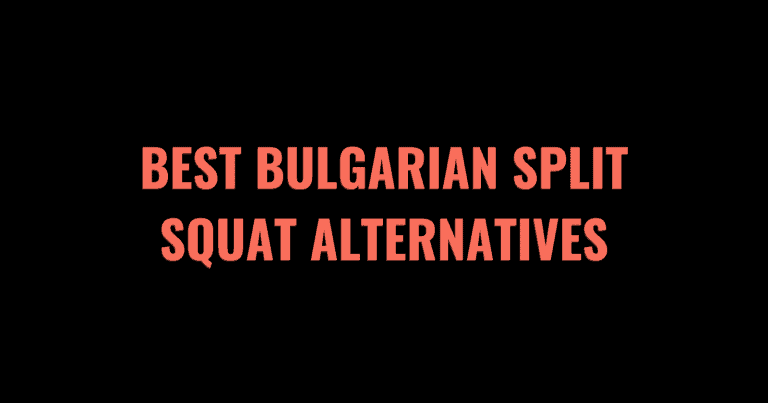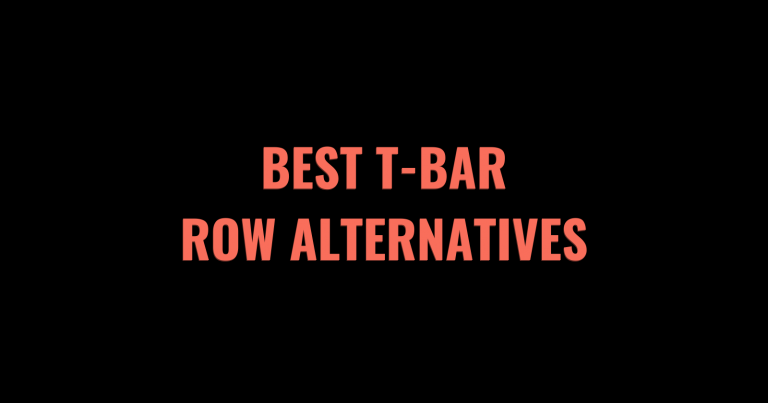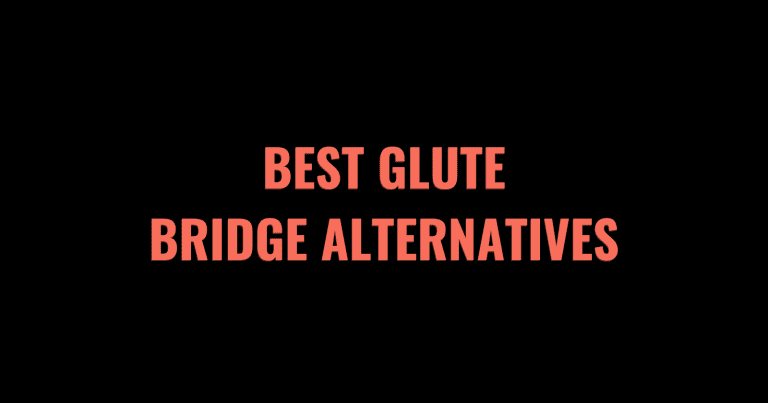The leg extension is an effective isolation machine-based exercise that directly targets the quads. The quads, also known as the quadriceps, are a group of four muscles located on the front of your upper leg. The quads are primarily responsible for knee extension and hip flexion.
Although a leg extension is effective, it may not be the best quad exercise, depending on various factors, such as equipment availability, physical ability, personal goals, and more. Thankfully, several other exercises can be performed to build and strengthen your quads, but they are not all created equal.
Here, you will find the 10 best leg extension alternatives! We’ve outlined why each one is included, which one may be best for you, how to perform them correctly, and provide some tips and tricks.
Keep reading to learn more!
Table of Contents
- 1 The 10 Best Leg Extension Alternatives
- 2 When to choose a leg extension alternative
- 3 Muscles worked by the leg extension
- 4 Frequently Asked Questions
- 5 Key Takeaways
- 6 Other Alternative Exercises
- 6.1 The 8 Best Hammer Curl Alternatives
- 6.2 The 10 Best Box Jump Alternatives
- 6.3 The 10 Best Bent Over Row Alternatives
- 6.4 The 10 Best Lat Pulldown Alternatives
- 6.5 The 9 Best Lunge Alternatives
- 6.6 The 10 Best Plank Alternatives
- 6.7 The 10 Best Bulgarian Split Squat Alternatives
- 6.8 The 8 Best Decline Bench Press Alternatives
- 6.9 The 9 Best T-Bar Row Alternatives
- 6.10 The 8 Best Tricep Dip Alternatives
- 6.11 The 9 Best Pendlay Row Alternatives
- 6.12 The 8 Best Ab Rollout Alternatives
- 6.13 The 12 Best Pull-Up Alternatives
- 6.14 The 10 Best Hack Squat Alternatives
- 6.15 The 10 Best Glute Bridge Alternatives
The 10 Best Leg Extension Alternatives
- Heel-Elevated Back Squats
- Front Squats
- Hack Squats
- Lunges
- Bulgarian Split Squats
- Leg Press
- Cable Leg Extension
- Goblet Squat
- Sissy Squat
- Dumbbell Step-Ups
Heel Elevated Back Squats
When to perform heel elevated back squats
Two major downsides to a leg extension are that it’s a machine-based exercise, and trains only the quads. They may be a good accessory exercise, but they shouldn’t be your primary movement. Doing a compound free-weight exercise, such as barbell squats, will give you more bang for your buck because you’re training multiple muscles at one time.
If your primary goal is to build and strengthen your quads, then you can make a few adjustments to the barbell back squat to emphasize the quads. For example, doing heel elevated back squats is an excellent way to overload the quads while minimizing hamstring and glute engagement. Not to mention, heel elevated back squats are more functional and will have greater carry-over to other lifts and activities of daily living.
You can use a pair of 5lb plates, Olympic weightlifting shoes, or heel wedges to elevate your heels. Unlike a leg extension machine, you won’t be limited by the machine’s path of motion with a barbell squat. Heel elevated squats are pretty demanding, so it’s a good idea to perform them at the beginning of a workout.
How to perform heel elevated back squats
- To do this exercise, you will need a squat rack, Olympic barbell, Olympic plates, and weight clips.
- Set up a squat rack to the appropriate height (the barbell should sit just below shoulder level, and it should be easy to un-rack and re-rack). Next, adjust the height of the safety bars according to your squat depth.
- Place the barbell on the rack, load an appropriate amount of weight onto each side, and attach the weight clips. Set the heel wedges on the floor about 2-3 steps away from the rack.
- Step under the barbell and place the barbell on your upper traps. Grab each side of the barbell to help hold it in the proper position.
- Un-rack the barbell by standing up and taking 2-3 steps backward. Place your heels on the wedges.
- Take a deep breath, brace your core, and begin to squat by pushing your hips back slightly and bending at the knees.
- Keep going until your hips pass just below parallel, then pause for 1-2 seconds.
- After the pause, exhale as you drive through your heels and extend your knees and hips to return to the starting position. Focus on keeping your knees out.
- Repeat for the desired number of repetitions.
For a complete guide on how to perform heel-elevated barbell back squats, check out the video below!
Heel elevated back squat tips
- Avoid letting your knees cave in, especially on the concentric portion of the lift.
- Squat down as far as you comfortably can.
- Push through your heels.
- Don’t lock out at the top to keep tension on the quads.
- Flat-soled shoes or Olympic weightlifting shoes work best for this exercise.
Front Squats
When to perform front squats
The front squat is another squat variation that emphasizes the quads, especially since the weight is loaded on the front of your shoulders as opposed to your upper back. Front squats are very popular in Olympic weightlifting and CrossFit because they translate well to a snatch, clean/jerk, thruster, and other exercises.
Compared to a leg extension, the front squat is a more functional movement that engages more muscles. So if you’re an athlete and/or limited on the amount of time you can train, then the front squat will provide you with a greater amount of benefits than a leg extension.
The front squat should be performed near the beginning of a leg-focused workout. If you have limited shoulder mobility and cannot get into the proper positioning, try a few variations to see what feels most comfortable.
However, if you want to compete in a specific sport, such as CrossFit, you have to get used to an Olympic-style front rack position. To engage the quads even more, put a pair of plates under your heels or use Olympic weightlifting shoes.
How to perform front squats
- To perform this exercise, you will need a squat rack, Olympic barbell, Olympic plates, and weight clips.
- Adjust the height of the squat rack to just below shoulder level. You should be able to easily un-rack and re-rack the barbell without going on your toes or squatting too far down.
- Adjust the safety bars to just below your squat depth. Place the barbell on the rack, load an appropriate amount of weight on each side, and secure the weight clips.
- Step up to the barbell, grab the barbell with a pronated grip just outside of shoulder-width, bring your elbows up, and place the barbell on your front delts. Rotate your hands so that 2-3 fingers are wrapped around the bar.
- Un-rack the barbell by standing up and taking 2-3 steps backward.
- Assume a shoulder-width stance with your toes pointed slightly out.
- Take a deep breath, brace your core, and begin squatting by pushing your hips slightly back and bending your knees. Keep your chest and elbows up at all times.
- Once your hips pass just below parallel, pause for 1-2 seconds.
- Exhale as you push through your heels, keep your knees out, and stand back up by extending your hips and knees.
- Repeat for the desired number of repetitions.
In the video below, Jeff Nippard demonstrates how to front squat with proper form and highlights common mistakes to avoid!
Front squat tips
- A weightlifting belt isn’t a necessity, but it may help you brace better, which will translate to being able to lift more weight over time.
- Push through your heels.
- Don’t let your knees cave in, especially on the concentric portion of the lift.
- Try out different front rack positions to see what feels most comfortable.
Hack Squats
When to perform hack squats
A hack squat is a great option if you want to perform another machine-based exercise that hammers the quads instead of a leg extension. The hack squat machine mimics a barbell squat, except it doesn’t require as many stabilizer muscles because the sled is there for support. Unlike a barbell back squat, you can safely train to failure without a spotter since there’s less injury risk and built-in safety mechanisms.
Compared to a leg press machine, you are more upright during a hack squat, and the weight is loaded on the shoulders. Arguably, the hack squat will have great carryover over other movements, including the barbell front and back squat.
Since the hack squat machine is a compound movement, it will work more muscles than a leg extension, so you get more out of the exercise. If your gym has a hack squat, we recommend giving it a try! For optimal results, perform the hack squat towards the beginning of a leg-focused workout.
How to perform hack squats
- Adjust the height of the sled to where you can easily un-rack and re-rack the sled with a slight bend in your knees. Adjust the height of the platform as needed (only an option on some machines).
- Place an appropriate amount of weight on each side of the sled.
- Step onto the platform and assume a shoulder-width stance with your feet pointed slightly out.
- Lean back, and brace your back, head, neck, and shoulders against the support pads.
- Straighten your legs to lift the sled, then move the racking mechanism out to the sides by moving the handles.
- Take a deep breath, brace your core, and begin the movement by bending at your knees and hips. Imagine that you’re sitting on a chair).
- Once your hips pass just below parallel or your knees create a 90-degree angle, pause for 1-2 seconds.
- Exhale as you push through your heels to extend your legs and return back to the starting position. Don’t lock your knees at the top of the lift to keep tension on the quads.
- Repeat for the desired number of repetitions.
In the video below, IFBB Pro bodybuilder, Fouad Abiad, demonstrates how to perfect your hack squat form!
Hack squat tips
- Push through your heels.
- To target the quads, place your feet closer together and lower on the platform.
- Adjust the angle of the platform to what feels most comfortable to you.
- Flat-soled shoes are ideal for this exercise.
- A weightlifting belt isn’t necessary but may help you brace better and lift more weight.
Lunges
When to perform lunges
Lunges are a phenomenal exercise for the lower body because they are one of the few unilateral movements. Unilateral exercises involve working one limb at a time, which helps correct and prevents strength imbalances.
Oftentimes, one leg is stronger or more developed than the other, so it’s a good idea to add unilateral exercises into your workout routine. Lunges are great because you can do them anywhere with little to no equipment, whereas, with a leg extension exercise, you need a machine.
There are several variations you can do depending on your skill level, what muscle you’re trying to target, and equipment selection. For instance, you can do reverse lunges, forward lunges, walking lunges, bodyweight, barbell lunges, etc. Not to mention, lunges are a very functional movement because you’re in a split stance, which translates to running, walking, and even jumping.
If you need to improve your balance and get stronger, more muscular legs, you can’t go wrong with lunges! Lunges aren’t as taxing as front squats or back squats, so you can really perform them at any point during a leg workout. However, if you need to get more proficient at the movement, it’s best to do them near the beginning when you’re not fatigued.
How to perform lunges
- Grab a pair of dumbbells with a neutral grip (palms facing your torso).
- Stand tall with a slightly more narrow than shoulder-width stance.
- Take a deep breath, brace your core, look straight ahead, and take one step forward with your right leg.
- Bend your right knee until the left knee touches the ground. Keep the ball of your left foot on the ground.
- Once your left leg makes contact with the ground, pause for 1-2 seconds.
- Exhale as you push through the heel of your right leg while simultaneously lifting your left leg and bringing it forward until you’re in a standing position.
- Alternate legs after each rep and repeat for the desired number of repetitions.
Check out the video below from Mind Pump Media to see how to correctly perform lunges!
Lunge tips
- Flat-soled shoes work best for this exercise.
- Use a full range of motion (touch your knee to the ground during each rep and stand all the way up.)
- If you want to emphasize your quads, step closer together.
- If you want to target your glutes and hamstrings, step further apart.
- Don’t let your knee go past your toe on the front leg.
Bulgarian Split Squats
When to perform Bulgarian split squats
Bulgarian split squats are considered to be a hybrid of a squat and lunge. Similar to lunges, they are great for improving balance and strength and adding muscle mass to your lower body. If you don’t have room for walking lunges, Bulgarian split squats are the next best option because you stay in one place the entire time.
Unlike a leg extension, Bulgarian split squats require minimal equipment, all you need is your body, some dumbbells, kettlebells, a weight vest, a barbell, and a box or bench to place your foot on. Whether you’re working out at home, at a commercial gym, or on the road, you can still do this exercise.
Bulgarian split squats can be performed any time during a leg workout, but near the beginning is ideal so you’re not too fatigued. If you’re new to this exercise, we recommend starting with just your body weight. As you get better at the exercise, you can start to add weight as needed.
For those with a muscular imbalance, start with your weaker leg and match the number of reps with the stronger leg. Over time, this will help correct the imbalance, reduce injury risk, and have good carryover to bilateral lower body exercises.
How to perform Bulgarian split squats
- To do this exercise, you’ll need a pair of dumbbells and a flat bench or box to place your foot on.
- Grab a pair of dumbbells with a neutral grip. Stand facing away from the box and take 3 steps forward.
- Assume a split-stance position by lifting your left leg up and placing the top of your foot on the box. There should be a slight bend in your right (front) leg.
- Take a deep breath, keep your chest up, and begin to lunge down by bending your right leg.
- Keep going until your right (front) knee forms a 90-degree angle or your left (back) knee touches the ground.
- Pause for 1-2 seconds, then exhale as you push off your front foot to return to the starting position.
- Repeat for the desired number of repetitions, then switch legs.
In the video below, Scott Herman demonstrates how to do a Bulgarian split squat with the correct form.
Bulgarian split squat tips
- Focus on pushing off the heel of your front leg.
- Use a closer stance to target the quads more.
- Use a wide stance to target the glutes/hamstrings more.
- If your grip is a limiting factor, try using lifting straps.
Leg Press
When to perform the leg press
Until this point, most of the exercises we’ve covered are considered full-body exercises because your upper and lower body are working to perform the movement. One unique feature of the leg extension is that you can target the quads without taxing the rest of the body. A leg press machine is a great option if that’s your primary goal.
The leg press is a compound movement, but the upper body is doing little to no work because it’s supported against a pad. Not to mention, the weight is loaded at the hips, not the shoulders, which drastically reduces spinal loading/compression.
Besides the leg extension exercise, a leg press is arguably the closest you can get to isolating the quads. Depending on where you place your feet, you can emphasize your quads while limiting glute and hamstring involvement. We suggest a close stance with your feet slightly pointed out and placed lower on the platform to target the quads.
The leg press isn’t as demanding as a squat, so you can perform them at any point during a leg workout. They are normally programmed as an accessory lift to a free-weight squat variation.
How to perform the leg press
- Adjust the height of the platform so you can easily un-rack and re-rack the sled. Adjust the angle of the back support pad to a position that feels most comfortable and allows you to work through an adequate range of motion.
- Place an appropriate amount of weight on each side.
- Sit down on the machine and position your feet in the middle of the platform, approximately shoulder-width apart, with your toes pointed slightly outward.
- Unrack the platform by straightening your knees to push the sled away from you, then move the safety bars out to the side by rotating the handles.
- Take a deep breath, brace your core, and begin slowly lowering the platform towards your chest by bending your knees and hips.
- Once your knees form a 90-degree angle, pause for 1-2 seconds.
- Exhale as you push through your heels to drive the sled back to the starting position. Avoid locking your knees at the top to keep tension on the quads.
- Repeat for the desired number of repetitions.
Leg press tips
- To target the quads, use a close stance and keep your feet positioned lower on the platform.
- To target the glutes/hamstrings, use a wider stance with your feet positioned higher on the platform.
- Drive through your heels during the concentric portion of the lift.
- Flat-soled shoes are ideal for this exercise.
- If one leg is more dominant, consider doing a single-leg leg press.
Watch the video below to find out how to perform the leg press with perfect form and 7 common mistakes to avoid!
Cable Leg Extension
When to perform cable leg extensions
Cable leg extensions are a good leg extension alternative for those that don’t have access to a leg extension machine but still want to isolate the quads. What’s more, you have to perform this exercise one leg at a time, which, as we’ve mentioned, helps prevent injuries and builds a symmetrical physique.
In order to perform cable leg extensions, it’s important to have a heavy-duty ankle cuff on hand that can support a good amount of weight, depending on how strong you are. You can do this exercise as a pre-exhaust, meaning that you perform it before a compound lift, or you can do it near the end of a workout to finish the quads.
Want more ideas? See our round up of the best cable exercises for legs.
How to perform a cable leg extension
- To do this exercise, you’ll need a box, cable pulley machine, and ankle cuff.
- Place the box directly in front of the cable stack, then select an appropriate amount of weight.
- Adjust the cable pulley to the lowest setting, and secure the ankle cuff to your right or left leg. Sit down on the box, then attach it to the cable.
- Allow your legs to hang down with your knees at a 90-degree angle. Before starting, grab the box on each side and pull down to keep your butt on the box.
- Take a deep breath, brace your core, then extend your right/left leg until it’s straight and you feel a strong contraction in the quad.
- At the top of the rep, squeeze the quad for 1-2 seconds.
- Exhale as you slowly lower your leg back to the starting position.
- Repeat for the desired number of repetitions, then switch legs.
Check out the video below to see how to set up and perform a single-leg cable extension!
Cable leg extension tips
- Start with your weaker leg and match the weight and number of repetitions with the stronger leg.
- Pull down on the box to hold yourself in the proper position.
- Stick to a higher rep range with this exercise, such as 10-20 reps.
Goblet Squat
When to perform goblet squats
If you lack the mobility to perform a proper barbell squat, then a goblet squat is a good exercise to try out. Since the weight is loaded in front of your body, it forces your body to remain upright and makes it easier to learn proper squat form.
Furthermore, the front rack position engages more of the quads and less of the hamstrings/glutes. To further emphasize the quads, you can do heel-elevated goblet squats by using a heel wedge or placing 5lb plates under your heels.
Another benefit of goblet squats is that you don’t need a machine or a squat rack, which is ideal for those that don’t have access to a gym. In addition, goblet squats are more functional than a leg extension machine and carry greater carryover to other movements and activities of daily living.
You can perform goblet squats at any point during a lower body workout since they aren’t as taxing as barbell squats.
How to perform goblet squats
- Place a heavy dumbbell or kettlebell on a flat bench or box.
- Grab the end of a dumbbell or the horns of a kettlebell with both hands and lift it towards your chest by bending your elbows. This dumbbell will stay in this position the entire time.
- Assume a shoulder-width stance with your toes pointed slightly out. Keep your chest and elbows up.
- Take a deep breath, brace your core, and begin to squat by slightly pushing your hips back and bending your knees.
- Continue to lower yourself until your knees form a 90-degree angle or your hips pass below parallel.
- At the bottom of the squat, pause for 1-2 seconds.
- Exhale as you push through your heels and extend your knees and hips to stand up.
- Repeat for the desired number of repetitions.
Scott Herman shows you how to perform a goblet squat properly in the video below!
Goblet squat tips
- Envision that you’re sitting down on a chair.
- Push through your heels on the concentric portion of the lift.
- Flat-soled shoes or Olympic weightlifting shoes work best.
- Elevate your heels to engage your quads more.
- Place the dumbbell or kettlebell on an elevated surface so it’s easier to get into position.
Sissy Squat
When to perform sissy squats
The sissy squat is an old-school exercise that trains the quads, core, and hip flexors at the same time. Since the leg extension isolates the quads, we decided to pick this squat variation over a traditional bodyweight squat because it hammers the quads.
Most people perform this exercise with just their body weight, but you can add resistance by holding a plate or dumbbell or wearing a weight vest. With that said, the sissy squat is a bit challenging to do with proper form, so we recommend starting with your bodyweight and adding weight once you feel comfortable.
It’s quite common for people to do a superset that includes sissy squats. For example, you could perform a leg press and then do sissy squats immediately after. This sequence will place a significant amount of metabolic stress on the quads, stimulating them to grow. You can do sissy squats at any point during a leg workout.
During a sissy squat, your heels need to be elevated. That can be accomplished by rising on your toes under your own power, or if that’s too difficult for you, placing a plate under your heels. The key to this movement is keeping your hips extended and just moving at the knee.
How to perform sissy squats
- Assume a shoulder-width stance with your toes pointed forward.
- Start by rising on your toes or elevating your heels by placing them on the edge of a plate.
- Take a deep breath, brace your core and glutes, and start to push your knees forward and lean your torso back while keeping your hips extended (imagine that you’re doing the limbo). You can either place your hands on your hips, raise them forward or grab onto a support pole to help you balance.
- Lower as far down as you comfortably can without letting your hips flex.
- Once you reach your end range of motion, you should feel a strong stretch in the quads.
- Pause for 1-2 seconds, then return to the starting position by extending your knees and contracting your quads.
- At the top of each rep, squeeze your quads.
- Repeat for the desired number of repetitions.
It’s crucial to perform sissy squats with the correct form to get the most out of this exercise, so we highly recommend watching the exercise video demonstration provided below!
Sissy squat tips
- Keep your hips extended the entire movement.
- Grab onto a support beam with one hand to help you balance.
- This exercise will help improve your mind-muscle connection with your quads.
Feet Forward Smith Machine Squats
When to perform smith machine squats
Feet forward smith machine squats are a good leg extension alternative and closely mimic a hack squat. They place more tension on the quads compared to the glutes/hamstrings. Positioning your feet slightly closer than shoulder width and 2-3 inches in front of the bar path allows you to achieve a greater range of motion which is ideal for quad hypertrophy.
You may not be able to move as much weight as a barbell squat, but you will feel it more in your quads. Smith machine squats are ideal for those that want to train to failure but don’t have a spotter since there are built-in safety bars at multiple points on the machine. Plus, there’s less recruitment of your stabilizer muscles, so your quads can be the limiting factor instead of other muscle groups.
Feet forward smith machine squats heavily target the quads while training other muscles at the same time, unlike a leg extension machine. For optimal performance, we suggest performing this exercise near the beginning of your workout.
How to perform smith machine squats
- Adjust the height of the smith machine to where the bar is just below shoulder level. You should be able to unrack and re-rack the barbell without having to go on your toes or squat down. Load an appropriate amount of weight on each side.
- Step under the bar, assume a shoulder-width stance, place the bar against your upper traps, and grab each side of the bar.
- Unrack the bar by standing straight up and rotating the bar backward or forward (depending on the machine).
- Move your feet 2-3 inches forward and point your toes forward or slightly out.
- Take a deep breath, brace your core, and begin to squat by pushing your hips slightly back and bending at the knees.
- Once your hips pass just below parallel and/or your knees for a 90-degree angle, pause for 1-2 seconds.
- Exhale as you drive through your heels, extend your knees, and push your hips forward to return to the starting position.
- Repeat for the desired number of repetitions.
In the short video below, Jared Feather and Dr. Mike Israetel cover how to perform a feet-forward smith machine squat:
Smith machine squat tips
- Flat-soled or Olympic weightlifting shoes work best for this exercise.
- A lifting belt is not required, but it may help improve your core stability.
- On the concentric portion of the lift, focus on keeping your knees out and driving through your heels.
When to choose a leg extension alternative
The leg extension is an effective quad-building exercise but is not ideal for many individuals. It’s most commonly used as an accessory exercise by bodybuilders looking to add more shape and definition to their quads.
Out of all the quad exercises that exist, it’s arguably the least functional. Therefore it doesn’t have good carryover to other lifts or activities of daily living. With that said, if you are injured and cannot perform a squat or lunge, a leg extension can help retain some quad size and strength. However, leg extensions may be contraindicated depending on your injury because they place more strain on the ACL (anterior cruciate ligament).
For those of you who are athletes, doing a lunge and squat variation will provide you with a lot more benefits than a leg extension. Not to mention, those exercises train multiple muscles at once. So if you’re limited on time, it’s best to do the compound movement as opposed to isolation exercises.
Some other reasons why you may seek leg extension alternatives is because you simply don’t have access to a leg extension machine, or the one you do have doesn’t fit your body right. There are countless reasons why doing a different quad exercise will be more beneficial, but the reason will depend on the person.
Muscles worked by the leg extension
The primary muscle group trained by the leg extension machine is the quadriceps. Unlike compound exercises, since the leg extension is an isolation exercise, it doesn’t engage any other muscles.
Primary Muscles
- Quadriceps
- Rectus Femoris
- Vastus Lateralis
- Vastus Medialis
- Vastus Intermedius
Frequently Asked Questions
How do you do a leg extension without the machine?
It’s challenging to do leg extensions with a machine, but it can be done. The two most practical ways are by using resistance bands or cables. You can sit on a box, secure the resistance band to a pole or squat rack and perform them that way.
If you have access to cables, then all you need is an ankle cuff and box. You can also perform a leg extension alternative and still adequately stimulate your quads.
Are leg extensions pointless?
Many people make the argument that leg extensions are a pointless exercise. But that couldn’t be further from the truth. Leg extensions effectively strengthen and build the quadriceps, especially the rectus femoris. When you are performing a squat or lunge, your hips and knees are flexing and extending simultaneously.
Since the rectus femoris crosses the knee and the hip, its length doesn’t really change during a squat, leg press, or lunge. So to train it optimally, doing leg extensions is vital because your hips stay fixed in one position, and the rectus femoris gets trained via knee extension.
Why should you never do leg extensions?
For most people, leg extensions are a safe and effective exercise. But there are a few people who should avoid them. If you recently had ACL reconstruction, leg extensions aren’t ideal because they place more stress on the ACL.
If you have overpowering quads, doing leg exercises that engage your glutes/hamstrings more is recommended to balance out your physique. On the other hand, if you’re an athlete, leg extensions aren’t nearly as beneficial compared to a squat or lunge variation. Those are just a few examples of people that may be better off avoiding the leg extension machine.
Key Takeaways
Leg extensions are a safe and effective machine-based isolation exercise that targets the quadriceps. They are very popular in bodybuilding to add definition and shape to their quads. If you don’t have access to a leg extension machine, there are numerous other quad-focused exercises you can perform that will yield similar or even better results. Leg extensions don’t have good carryover to other compound exercises or activities of daily living.
Depending on an individual’s goals, preferences, equipment availability, and physical ability, you may be better off doing some leg extension alternatives listed above! Leg extensions, like any other exercise, are not mandatory for building and strengthening your quads. Several other exercises can be performed.
Other Alternative Exercises
If you enjoyed this post, check out our other roundups of the best alternatives for other exercises.














